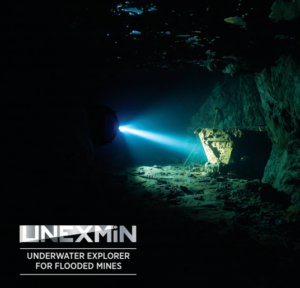13 organisations from 7 countries across Europe are collaborating in an ambitious project to develop a submersible robotic system for surveying and exploration of flooded mines. The €5M project, funded by the European Union’s Horizon 2020 research programme, includes the development of a Robotic Explorer (UX-1) for autonomous 3D mine mapping to gather valuable geological information that cannot be obtained in any other way: in general the mines will be too deep and dangerous for access by human divers.
 A multi-robot system based on UX-1 will represent new technology, made possible by recent developments in autonomy research allowing development of a completely new class of robots, capable of operating underground without remote control: UX-1 will be the first of its kind. Research challenges are related to miniaturisation and adaptation of deep sea robotic technology to this new application environment and to the interpretation of high volumes of multivariate geoscientific data.
A multi-robot system based on UX-1 will represent new technology, made possible by recent developments in autonomy research allowing development of a completely new class of robots, capable of operating underground without remote control: UX-1 will be the first of its kind. Research challenges are related to miniaturisation and adaptation of deep sea robotic technology to this new application environment and to the interpretation of high volumes of multivariate geoscientific data.
Pilot deployments will be carried out at mines with progressively more challenging conditions: Kaatiala feldspar/quartz mine (Finland), Urgeiriça uranium mine (Portugal) and Idrija mercury mine (Slovenia). The final, most ambitious demonstration will take place in the UK with the first modern survey of the Deep Ecton copper mine (UK) most of which has been flooded and inaccessible for over 150 years. This will demonstrate the system’s scalability from small missions to the largest ones by increasing the number of deployed autonomous drones, and supporting multi-robot cooperation in confined 3D spaces with real-time sensor and data fusion for reliable navigation and communications.
The development of UX-1 will open new exploration scenarios so that strategic decisions on reopening Europe’s abandoned mines, many of which may still contain critical raw materials, can be supported by real data which cannot be gathered in any other way.
Source: UNEXIM